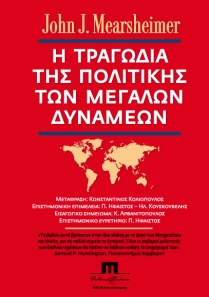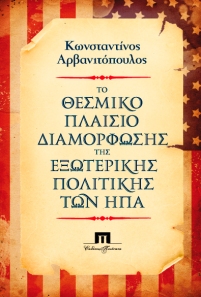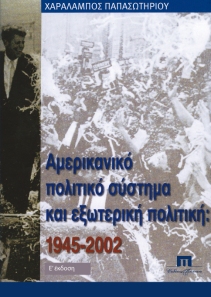 Το
ινστιτούτο από το οποίο απορρέουν κείμενα όπως αυτά που ακολουθούν δεν
είναι τυχαίο. Όπως πολλά άλλα ανάλογα ινστιτούτα στις ΗΠΑ αναλύει τις
προϋποθέσεις και τις παραμέτρους μιας πιθανής νέας αμερικανικής
στρατηγικής που θα επαναθεωρήσει την παραδοσιακή στρατηγική της
περιμέτρου της Ευρασίας (αυτά τα ζητήματα αναλύονται εμπεριστατωμένα στο
πρώτο κεφάλαιο του βιβλίου των Αρβανιτόπουλος, Ήφαιστος,Ευρωατλαντικές σχέσεις).
Για την Ελλάδα οι στρατηγικές που αναλύονται είναι πολύ ενδιαφέρουσες
γιατί αναφέρονται σε ένα πιθανό ρόλο και μια πιθανή θέση της Τουρκίας η
οποία ενδέχεται να φέρει μελλοντικά την Ελλάδα σε μια πολύ δυσμενή
στρατηγική κατάσταση. Η ανάλυση αναφέρεται, ουσιαστικά, σε ένα
γεωπολιτικά αναβαθμισμένο νεοτουρκικό κράτος το οποίο, επιπλέον, θα
μπορούσε υπό αυτές τις περιστάσεις να διαθέτει μεγαλύτερες δυνατότητες
στρατηγικής αυτονομίας και στρατηγικής ευελιξίας:
Το
ινστιτούτο από το οποίο απορρέουν κείμενα όπως αυτά που ακολουθούν δεν
είναι τυχαίο. Όπως πολλά άλλα ανάλογα ινστιτούτα στις ΗΠΑ αναλύει τις
προϋποθέσεις και τις παραμέτρους μιας πιθανής νέας αμερικανικής
στρατηγικής που θα επαναθεωρήσει την παραδοσιακή στρατηγική της
περιμέτρου της Ευρασίας (αυτά τα ζητήματα αναλύονται εμπεριστατωμένα στο
πρώτο κεφάλαιο του βιβλίου των Αρβανιτόπουλος, Ήφαιστος,Ευρωατλαντικές σχέσεις).
Για την Ελλάδα οι στρατηγικές που αναλύονται είναι πολύ ενδιαφέρουσες
γιατί αναφέρονται σε ένα πιθανό ρόλο και μια πιθανή θέση της Τουρκίας η
οποία ενδέχεται να φέρει μελλοντικά την Ελλάδα σε μια πολύ δυσμενή
στρατηγική κατάσταση. Η ανάλυση αναφέρεται, ουσιαστικά, σε ένα
γεωπολιτικά αναβαθμισμένο νεοτουρκικό κράτος το οποίο, επιπλέον, θα
μπορούσε υπό αυτές τις περιστάσεις να διαθέτει μεγαλύτερες δυνατότητες
στρατηγικής αυτονομίας και στρατηγικής ευελιξίας:
Μια αμερικανική στρατηγική
αποτροπής και ανάσχεσης της Ρωσίας, υποστηρίζει ο αναλυτής, θα πρέπει να
αναζητήσει ερείσματα και συμμαχίες σε μια ζώνη που αρχίζει από την
Βόρεια Ευρώπη και φτάνει στην Μέση Ανατολή διαμέσου της Τουρκίας
Εδώ ο αναλυτής αναφέρεται σε μια
μετατόπιση του κέντρου βάρους της αμερικανικής στρατηγικής από τη δυτική
στην κεντρική Ευρώπη υπογραμμίζοντας ρητά ότι οι ΗΠΑ θα πρέπει να
παρακάμψουν το ΝΑΤΟ. Πιο κάτω, όπου αναφέρεται στην ενεργειακή εξάρτηση
τόσο της κεντρικής Ευρώπης όσο και των κρατών που βρίσκονται σε αυτή τη
ζώνη, οδηγείται στο εύλογο συμπέρασμα ότι η διαχείριση στο βραχυχρόνιο
επίπεδο δεν είναι εύκολη.
Σίγουρα, για κάθε γνώστη της
αμερικανικής στρατηγικής τα ρεύματα σκέψης άλλοτε επικαλυπτόμενα και
άλλοτε αντικρουόμενα είναι πάντα πολλά και τα εναλλακτικά σενάρια
ελέγχου της κατανομής ισχύος διαρκή και ρευστά. Βλ. την ανάρτησή μας με
επίκεντρο την ανάλυση του Mearsheimer, Η τραγωδία της πολιτικής των μεγάλων δυνάμεων με τίτλο «Η σύρραξη στη Συρία και ο ανελέητος ηγεμονικός ανταγωνισμός ως καθοριστικός παράγων των περιφερειακών διενέξεων».
Υπάρχουν εντούτοις κάποιες
μεσοπρόθεσμες σταθερές που αφορούν το περιφερειακό «πελατειακό κράτος»
της αμερικανικής στρατηγικής. Όπως γνωρίζουμε το γεγονός ότι αυτό τον
ρόλο διαδραμάτιζε η Τουρκία για τις ΗΠΑ αποτέλεσε και την κύρια αιτία
πολλών δεινών της Ελλάδας μετά το 1945.

Η μετεξέλιξη της λανθάνουσας
αντιπαράθεσης των ναυτικών με τις ηπειρωτικές δυνάμεις (αυτές οι έννοιες
αναλύονται στο προαναφερθέν βιβλίο των Εκδόσεών μας Ευρωατλαντικές σχέσεις)
είναι ζωτικό ζήτημα για την ελληνική εξωτερική πολιτική. Πολύ πιο
σημαντικό και άμεσο, ενδέχεται να σχετίζεται άμεσα με τις εξελίξεις γύρω
από το κυπριακό, τους ενεργειακούς πόρους και τους ενεργειακούς
αγωγούς.
Όχι μόνο επειδή το αναφέρει ο
αναλυτής αλλά επειδή αυτό συνεπάγεται ο ανταγωνισμός των μεγάλων
δυνάμεων από καταβολής κόσμου, οι εξελίξεις των τελευταίων ετών και
κυρίως των τελευταίων μηνών καταμαρτυρούν πλέον σαφέστατα ότι
βρισκόμαστε στην αφετηρία παιγνίων ισχύος όπου η κάθε δύναμη επιδιώκει
τα μεγαλύτερα δυνατά ερείσματα στην επιδιωκόμενη νέα ισορροπία δυνάμεων.
Η αλλαγή της κατανομής ισχύος, όμως, τα παίγνια αναζήτησης νέων
ισορροπιών, οι ανελέητες στρατηγικές προσεγγίσεις των στρατηγικών
δρώντων και οι συμπληγάδες που στήνονται στις περιφέρειες είναι
εξελίξεις πολύ επικίνδυνες για μικρά, αδύναμα και απαθή κράτη. Η
καθημερινή διεθνής πρακτική το καταμαρτυρεί.
 Σε
κομβικές ιστορικές στιγμές τα γεγονότα που προσδιορίζουν μια
σταθεροποίηση νέων ισορροπιών είναι άλλοτε ορατά και άλλοτε αόρατα. Για
να μπορέσει ένα κράτος να συμμετέχει στα δρώμενα, να συναλλάσσεται, να
εξυπηρετεί τα συμφέροντά του και να επιβιώνει απαιτεί ύπαρξη εθνικής
στρατηγικής. Όλα δείχνουν πάντως ότι η Ελλάδα είναι ένας παθητικός
θεατής των εξελίξεων τη στιγμή που όχι μόνο συντελούνται μεγάλες
στρατηγικές ανακατατάξεις ερήμην μας, αλλά επιπλέον η Κύπρος όπου ζει το
ένα δέκατο του ελληνισμού εισέρχεται σε ανεπίστροφη τροχιά αποδοχής
ενός νέου σχεδίου Ανάν που όπως πολλοί υποστηρίζουν θέτουν το νησί υπό
την τουρκική επικυριαρχία και καθιστούν την Άγκυρα προνομιακό
διαπραγματευτή του γεωπολιτικών πλεονεκτημάτων της Κύπρου και των
πλουτοπαραγωγικών πόρων. Στις αναρτήσεις μας θα βρείτε πολλές αναλύσεις
για τη συντρέχουσα φάση του Κυπριακού. Αξίζει όμως να δει κανείς την
ανάλυση της «Έκθεσης εμπειρογνωμόνων» που αναρτήσαμε πριν λίγες μέρες: «Πλαίσιο Αρχών για μια δίκαιη λύση και βιώσιμη λύση του Κυπριακού με γνώμονα το Διεθνές και Ευρωπαϊκό Δίκαιο»,
από το Διεθνές Συμβούλιο Εμπειρογμωμόνων συκληθέν από την Πανελλήνια
Επιτροπή για Ευρωπαϊκή Λύση του Κυπριακού. Είναι μια εξαιρετικά
σημαντική μελέτη διακεκριμένων ακαδημαϊκών από όλο τον κόσμο για τη
διεθνή και ευρωπαϊκή νομιμότητα σε συνάρτηση με τη βιωσιμότητα της λύσης
και τις διάφορες προτάσεις που και τώρα κυκλοφορούν.
Σε
κομβικές ιστορικές στιγμές τα γεγονότα που προσδιορίζουν μια
σταθεροποίηση νέων ισορροπιών είναι άλλοτε ορατά και άλλοτε αόρατα. Για
να μπορέσει ένα κράτος να συμμετέχει στα δρώμενα, να συναλλάσσεται, να
εξυπηρετεί τα συμφέροντά του και να επιβιώνει απαιτεί ύπαρξη εθνικής
στρατηγικής. Όλα δείχνουν πάντως ότι η Ελλάδα είναι ένας παθητικός
θεατής των εξελίξεων τη στιγμή που όχι μόνο συντελούνται μεγάλες
στρατηγικές ανακατατάξεις ερήμην μας, αλλά επιπλέον η Κύπρος όπου ζει το
ένα δέκατο του ελληνισμού εισέρχεται σε ανεπίστροφη τροχιά αποδοχής
ενός νέου σχεδίου Ανάν που όπως πολλοί υποστηρίζουν θέτουν το νησί υπό
την τουρκική επικυριαρχία και καθιστούν την Άγκυρα προνομιακό
διαπραγματευτή του γεωπολιτικών πλεονεκτημάτων της Κύπρου και των
πλουτοπαραγωγικών πόρων. Στις αναρτήσεις μας θα βρείτε πολλές αναλύσεις
για τη συντρέχουσα φάση του Κυπριακού. Αξίζει όμως να δει κανείς την
ανάλυση της «Έκθεσης εμπειρογνωμόνων» που αναρτήσαμε πριν λίγες μέρες: «Πλαίσιο Αρχών για μια δίκαιη λύση και βιώσιμη λύση του Κυπριακού με γνώμονα το Διεθνές και Ευρωπαϊκό Δίκαιο»,
από το Διεθνές Συμβούλιο Εμπειρογμωμόνων συκληθέν από την Πανελλήνια
Επιτροπή για Ευρωπαϊκή Λύση του Κυπριακού. Είναι μια εξαιρετικά
σημαντική μελέτη διακεκριμένων ακαδημαϊκών από όλο τον κόσμο για τη
διεθνή και ευρωπαϊκή νομιμότητα σε συνάρτηση με τη βιωσιμότητα της λύσης
και τις διάφορες προτάσεις που και τώρα κυκλοφορούν. Τα βιβλία μας για τις ΗΠΑ που σχετίζονται άμεσα με αυτή την ανάλυση είναι τα εξής:
Τα βιβλία μας για τις ΗΠΑ που σχετίζονται άμεσα με αυτή την ανάλυση είναι τα εξής:John Mearsheimer, Η τραγωδία της πολιτικής των μεγάλων ευρωπαϊκών δυνάμεων
Αρβανιτόπουλος Κ., Ήφαιστος Π., Ευρωατλαντικές σχέσεις
Παπασωτηρίου Χ., Αμερικανικό πολιτικό σύστημα και εξωτερική πολιτική, 1945-2002
Αρβανιτόπουλος Κ., Το θεσμικό πλαίσιο διαμόρφωσης της εξωτερικής πολιτικής των ΗΠΑ
Αρβανιτόπoυλος Κ., Η αμερικανική εξωτερική πολιτική μετά τον Ψυχρό πόλεμο
From Estonia to Azerbaijan: American Strategy After Ukraine
TUESDAY, MARCH 25, 2014 – 03:08 Print Text Size
As I discussed last week, the fundamental problem that Ukraine poses for Russia, beyond a long-term geographical threat, is a crisis in internal legitimacy. Russian President Vladimir Putin has spent his time in power rebuilding the authority of the Russian state within Russia and the authority of Russia within the former Soviet Union. The
events in Ukraine undermine the second strategy and potentially the
first. If Putin cannot maintain at least Ukrainian neutrality, then the
world’s perception of him as a master strategist is shattered, and the
legitimacy and authority he has built for the Russian state is, at best,
shaken.
Whatever the origins of the events in Ukraine, the United States is now
engaged in a confrontation with Russia. The Russians believe that the
United States was the prime mover behind regime change in Ukraine. At
the very least, the Russians intend to reverse events in Ukraine. At
most, the Russians have reached the conclusion that the United States
intends to undermine Russia’s power. They will resist. The United States
has the option of declining confrontation, engaging in meaningless sanctions against
individuals and allowing events to take their course. Alternatively,
the United States can choose to engage and confront the Russians.
A failure to engage at this point would cause countries around Russia’s
periphery, from Estonia to Azerbaijan, to conclude that with the United
States withdrawn and Europe fragmented, they must reach an accommodation
with Russia. This will expand Russian power and open the door to
Russian influence spreading on the European Peninsula itself. The United States has
fought three wars (World War I, World War II and the Cold War) to
prevent hegemonic domination of the region. Failure to engage would be a
reversal of a century-old strategy.
The American dilemma is how to address the strategic context in a global
setting in which it is less involved in the Middle East and is
continuing to work toward a “pivot to Asia.”
Nor can the United States simply allow events to take their course. The
United States needs a strategy that is economical and coherent
militarily, politically and financially. It has two advantages. Some
of the countries on Russia’s periphery do not want to be dominated by
her. Russia, in spite of some strengths, is inherently weak and does not
require U.S. exertion on the order of the two World Wars, the Cold War
or even the Middle East engagements of the past decade.
The Russian and U.S. Positions
I discussed Russian options on Ukraine last week. Putin is now in a
position where, in order to retain with confidence his domestic
authority, he must act decisively to reverse the outcome. The problem is
there is no single decisive action that would reverse events.
Eventually, the inherent divisions in Ukraine might reverse events.
However, a direct invasion of eastern Ukraine would simply solidify
opposition to Russia in Kiev and trigger responses internationally that
he cannot predict. In the end, it would simply drive home that although
the Russians once held a dominant position in all of Ukraine, they now
hold it in less than half. In the long run, this option — like other
short-term options — would not solve the Russian conundrum.
Whatever Putin does in Ukraine, he has two choices. One is simply to
accept the reversal, which I would argue that he cannot do. The second
is to take action in places where he might achieve rapid diplomatic and
political victories against the West — the Baltics, Moldova or the
Caucasus — while encouraging Ukraine’s government to collapse into
gridlock and developing bilateral relations along the Estonia-Azerbaijan
line. This would prevent a U.S. strategy of containment — a strategy
that worked during the Cold War and one that the Europeans are incapable
of implementing on their own. This comes down to the Americans.

The New Containment
The United States has been developing, almost by default, a strategy not of disengagement but of indirect engagement. Between
1989 and 2008, the U.S. strategy has been the use of U.S. troops as the
default for dealing with foreign issues. From Panama to Somalia,
Kosovo, Afghanistan and Iraq, the United States followed a policy of
direct and early involvement of U.S. military forces. However, this was
not the U.S. strategy from 1914 to 1989. Then, the strategy was to
provide political support to allies, followed by economic and military
aid, followed by advisers and limited forces, and in some cases
pre-positioned forces. The United States kept its main force in reserve
for circumstances in which (as in 1917 and 1942 and, to a lesser degree,
in Korea and Vietnam) allies could not contain the potential hegemon.
Main force was the last resort.
This was primarily a strategy of maintaining the balance of power. The
containment of the Soviet Union involved creating an alliance system
comprising countries at risk of Soviet attack. Containment was a balance
of power strategy that did not seek the capitulation of the Soviet
Union as much as increasing the risks of offensive action using allied
countries as the first barrier. The threat of full U.S. intervention,
potentially including nuclear weapons, coupled with the alliance
structure, constrained Soviet risk-taking.
Because the current Russian Federation is much weaker than the Soviet
Union was at its height and because the general geographic principle in
the region remains the same, a somewhat analogous balance of power
strategy is likely to emerge after the events in Ukraine. Similar to the
containment policy of 1945-1989, again in principle if not in detail,
it would combine economy of force and finance and limit the development
of Russia as a hegemonic power while exposing the United States to
limited and controlled risk.
The coalescence of this strategy is a development I forecast in two books, The Next Decade and The Next 100 Years,
as a concept I called the Intermarium. The Intermarium was a plan
pursued after World War I by Polish leader Jozef Pilsudski for a
federation, under Poland’s aegis, of Central and Eastern European
countries. What is now emerging is not the Intermarium, but it is close.
And it is now transforming from an abstract forecast to a concrete, if
still emergent, reality.
Forces Leading to the Alliance’s Emergence
A direct military intervention by the United States in Ukraine is not
possible. First, Ukraine is a large country, and the force required to
protect it would outstrip U.S. capabilities. Second, supplying such a
force would require a logistics system that does not exist and would
take a long time to build. Finally, such an intervention would be
inconceivable without a strong alliance system extending to the West and
around the Black Sea. The United States can supply economic and
political support, but Ukraine cannot counterbalance Russia and the
United States cannot escalate to the point of using its own
forces. Ukraine is a battleground on which Russian forces would have an
advantage and a U.S. defeat would be possible.
If the United States chooses to confront Russia with a military
component, it must be on a stable perimeter and on as broad a front as
possible to extend Russian resources and decrease the probability of
Russian attack at any one point out of fear of retaliation elsewhere.
The ideal mechanism for such a strategy would be NATO, which contains
almost all of the critical countries save Azerbaijan and Georgia. The
problem is that NATO is not a functional alliance. It was designed to
fight the Cold War on a line far to the west of the current line. More
important, there was unity on the principle that the Soviet Union
represented an existential threat to Western Europe.
That consensus is no longer there. Different countries have different
perceptions of Russia and different concerns. For many, a replay of the
Cold War, even in the face of Russian actions in Ukraine, is worse than
accommodation. In addition, the end of the Cold War has led to a massive
drawdown of forces in Europe. NATO simply lacks the force unless there
is a massive and sudden buildup. That will not occur because of the
financial crisis, among other reasons. NATO requires unanimity to act,
and that unanimity is not there.
The countries that were at risk from 1945 to 1989 are not the same as
those at risk today. Many of these countries were part of the Soviet
Union then, and the rest were Soviet satellites. The old alliance system
was not built for this confrontation. The Estonia-Azerbaijan line has
as its primary interest retaining sovereignty in the face of Russian
power. The rest of Europe is not in jeopardy, and these countries are
not prepared to commit financial and military efforts to a problem they
believe can be managed with little risk to them. Therefore, any American
strategy must bypass NATO or at the very least create new structures to
organize the region.
Characteristics of the Alliance
Each of the various countries involved is unique and has to be addressed
that way. But these countries share the common danger that events in
Ukraine could spread and directly affect their national security
interests, including internal stability. As I observed, the Baltics,
Moldova and the Caucasus are areas where the Russians could seek to
compensate for their defeat. Because of this, and also because of their
intrinsic importance, Poland, Romania and Azerbaijan must be the posts
around which this alliance is built.
The Baltic salient, 145 kilometers (90 miles) from St. Petersburg in Estonia, would be a target for Russian destabilization. Poland borders
the Baltics and is the leading figure in the Visegrad battlegroup, an
organization within the European Union. Poland is eager for a closer
military relationship with the United States, as its national strategy
has long been based on third-power guarantees against aggressors. The
Poles cannot defend themselves and the Baltics, given the combat
capabilities necessary for the task.
The Dniester River is 80 kilometers from Odessa, the main port on the
Black Sea for Ukraine and an important one for Russia. The Prut River is
about 200 kilometers from Bucharest, the capital of Romania. Moldova is between these two rivers. It is a battleground region, at least of competing political factions. Romania must
be armed and supported in protecting Moldova and in organizing
southeastern Europe. In Western hands, Moldova threatens Odessa,
Ukraine’s major port also used by Russia on the Black Sea. In Russian
hands, Moldova threatens Bucharest.
At the far end of the alliance structure I am envisioning is Azerbaijan,
on the Caspian Sea bordering Russia and Iran. Should Dagestan and
Chechnya destabilize, Azerbaijan — which is Islamic and majority Shiite
but secular — would become critical for limiting the regional spread of
jihadists. Azerbaijan also would support the alliance’s position in the
Black Sea by supporting Georgia and would serve as a bridge for
relations (and energy) should Western relations with Iran continue to
improve. To the southwest, the very pro-Russian Armenia — which has a
Russian troop presence and a long-term treaty with Moscow — could
escalate tensions with Azerbaijan in Nagorno-Karabakh. Previously, this
was not a pressing issue for the United States. Now it is. The security
of Georgia and its ports on the Black Sea requires Azerbaijan’s
inclusion in the alliance.
Azerbaijan serves a more strategic purpose. Most of the countries in the alliance are heavy importers of Russian energy;
for instance, 91 percent of Poland’s energy imports and 86 percent of
Hungary’s come from Russia. There is no short-term solution to this
problem, but Russia needs the revenue from these exports as much as
these countries need the energy. Developing European shale and importing
U.S. energy is a long-term solution. A medium-term solution, depending
on pipeline developments that Russia has tended to block in the past, is
sending natural gas from Azerbaijan to Europe. Until now, this has been
a commercial issue, but it has become a strategically critical issue.
The Caspian region, of which Azerbaijan is the lynchpin, is the only
major alternative to Russia for energy. Therefore, rapid expansion of
pipelines to the heart of Europe is as essential as providing Azerbaijan
with the military capability to defend itself (a capability it is
prepared to pay for and, unlike other allied countries, does not need to
be underwritten).
The key to the pipeline will be Turkey’s willingness to permit transit. I have not included Turkey as
a member of this alliance. Its internal politics, complex relations
and heavy energy dependence on Russia make such participation difficult.
I view Turkey in this alliance structure as France in the Cold War. It
was aligned yet independent, militarily self-sufficient yet dependent on
the effective functioning of others. Turkey, inside or outside of the
formal structure, will play this role because the future of the Black
Sea, the Caucasus and southeastern Europe is essential to Ankara.
These countries, diverse as they are, share a desire not to be dominated
by the Russians. That commonality is a basis for forging them into a
functional military alliance. This is not an offensive force but a force
designed to deter Russian expansion. All of these countries need modern
military equipment, particularly air defense, anti-tank and mobile
infantry. In each case, the willingness of the United States to supply
these weapons, for cash or credit as the situation requires, will
strengthen pro-U.S. political forces in each country and create a wall
behind which Western investment can take place. And it is an
organization that others can join, which unlike NATO does not allow each
member the right to veto.
The Practicality of the U.S. Strategy
There are those who would criticize this alliance for including members
who do not share all the democratic values of the U.S. State Department.
This may be true. It is also true that during the Cold War the United
States was allied with the Shah’s Iran, Turkey and Greece under
dictatorship and Mao’s China after 1971. Having encouraged Ukrainian
independence, the United States — in trying to protect that independence
and the independence of other countries in the region — is creating an
alliance structure that will include countries, such as Azerbaijan, that
have been criticized. However, if energy does not come from Azerbaijan,
it will come from Russia, and then the Ukrainian events will dissolve
into tragic farce. The State Department must grapple with the harsh
forces its own policies have unleashed. This suggests that the
high-mindedness borne of benign assumptions now proven to be illusions
must make way for realpolitik calculations.
The balance of power strategy allows the United States to use the
natural inclination of allies to bolster its own position and take
various steps, of which military intervention is the last, not the
first. It recognizes that the United States, as nearly 25 percent of the
world’s economy and the global maritime hegemon, cannot evade
involvement. Its very size and existence involves it. Nor can the United
States confine itself to gestures like sanctions on 20 people. This is
not seen as a sign of resolve as much as weakness. It does mean that as
the United States engages in issues like Ukraine and must make strategic
decisions, there are alternatives to intervention — such as alliances.
In this case, a natural alliance structure presents itself — a
descendant of NATO but shaped for this crisis, much like the alliance I
forecast previously.
In my view, Russian power is limited and has flourished while the United
States was distracted by its wars in the Middle East and while Europe
struggled with its economic crisis. That does not mean Russia is not
dangerous. It has short-term advantages, and its insecurity means that
it will take risks. Weak and insecure states with temporary advantages
are dangerous. The United States has an interest in acting early because
early action is cheaper than acting in the last extremity. This is a
case of anti-air missiles, attack helicopters, communications systems
and training, among other things. These are things the United States has
in abundance. It is not a case of deploying divisions, of which it has
few. The Poles, Romanians, Azerbaijanis and certainly the Turks can
defend themselves. They need weapons and training, and that will keep
Russia contained within its cauldron as it plays out a last hand as a
great power.
Editor’s Note: We
invite subscribers to access the full text of the chapters that focused
on Russia’s unsustainable revival in international affairs from George
Friedman’s 2011 book, The Next Decade, and his 2009 book, The Next 100 Years, by clicking the links below. Excerpts reprinted with permission from Doubleday, a division of Penguin Random House, Inc.


 Πιθανά στρατηγικά παίγνια ερήμην της Ελλάδας και της Κύπρου
Πιθανά στρατηγικά παίγνια ερήμην της Ελλάδας και της Κύπρου









Δεν υπάρχουν σχόλια:
Δημοσίευση σχολίου